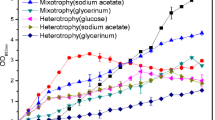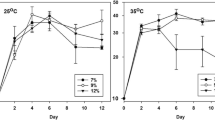Abstract
In order to study the effects of different nitrogen source and concentrationon the growth rate and fatty acid composition, a marine microalga Ellipsoidion sp. with a high content of eicosapentaenoic acid (EPA) wascultured in media with different nitrogen sources and concentrations.During the pre-logarithmic phase, the alga grew faster with ammoniumas N source than with nitrate, but the reverse applied during thepost-logarithmic phase. The alga grew poorly in N-free mediumor medium with urea as the sole N source. In the same growth phase,ammonium medium resulted in higher yield of total lipid, but the EPA yielddid not differ significantly different from that using nitrate medium. Themaximum growth rate occurred in medium containing 1.28 mmolL-1 sodium nitrate, while maximum EPA and total lipid contents werereached at 1.92 mmol L-1, when EPA accounted for 27.9% totalfatty acids. The growth rate kept stable when NH4Cl ranged from0.64 to 2.56 mmol L-1, and the maximum content of total lipidand EPA occurred in the medium with 2.56 mmol L-1NH4Cl. The EPA content was higher in the pre- thanpost-logarithmic phase, though the total lipid content was lower. Thehighest EPA content expressed as percent total fatty acid was 27.9% innitrate medium and and 39.0% in ammonium medium.
Similar content being viewed by others
References
Alonso DL, Molina GE, Sánchez PJA (1992) Isolation of clones of Isochrysis galbana rich in eicosapentaenoic acid. Aquaculture 102: 363-371.
Azov Y, Goldman JC (1982) Free ammonium inhibition of algal photosynthesis in intensive culture. Appl. environ. Microbiol. 43(4): 735-739.
Ben-Amotz A, Tornabene TG Thomas WH (1985) Chemical pro-file of selected species of microalgae with emphasis on lipids. J. Phycol. 21: 72-81.
Bligh EG, Dyer WJ (1959) A rapid method of total lipid extraction and purification. Can. J. Biochem. Physiol. 37: 911-917.
Brown MR, Jeffrey SW, Garland CD (1989) Nutritional aspects of microalgae used in mariculture: a literature review. CSIRO. Marine Laboratories Report 205, CSIRO Australia, 1-44.
Chismadha T, Borowitzka MA (1994) Effect of cell density and irradiance on growth, proximate composition and eicosapentaenoic acid production of Phaeodactylum tricornutum grown in tubular photobioreactor. J. appl. Phycol. 6: 67-74.
Fábregas J, Abalde J, Herrero C (1989) Biochemical composition and growth of the marine microalga Dunaliella tertiolecta (Butcher) with different ammonium nitrogen concentration as chloride, sulphate, nitrate and carbonate. Aquaculture 83: 289-304.
Fidago JP, Cid A, Abalde J, Herrero C (1995) Culture of the marine diatom Phaeodactylum tricormutum with different nitrogen sources: growth, nutrient conversion and biochemical composition. Cah. Biol. Mar. 36: 165-173.
Flores E, Guerrero MG, Losadh M (1980) Short term ammonium inhibition of nitrate utilization in Anacystis nidulans and other cyanobateria. Arch. Microbiol. 128: 137-140.
Hersh CM, Grumptin WG (1989) Atrazine tolerance of algae isolated from two agricultural streams. Environ. Toxicol. Chem. 8: 327-332.
Hodgson RA, Henderson RJ, Sargent JR, Leftley JW (1991) Patterns of variation in the lipid class and fatty acid composition of Nannochloropsis oculata (Eustigmatophyceae) during batch culture. I. The growth cycle. J. appl. Phycol. 3: 169-181.
Lepage G, Toy C (1984) Improved recovery of fatty acid through direct transesterification without prior extraction or purification. J. lipid Res. 25: 1391-1396.
Molina GE, Sánchez PJA (1992) EPA from Isochrysis galbana. Growth conditions and productivity. Process Biochem. 27: 299-305.
Morris I (1974) Nitrogen assimilation and protein synthesis. In Stewart WDP (ed.), Algal Physiology and Biochemistry. Blackwell, Oxford.
Otero A, Fábregas J (1997) Changes in the nutrient composition of Tetraselmis suecica cultured semicontinuously with different nutrient concentrations and renewal rates. Aquaculture 159: 111-123.
Provasoli L (1968) Media and prospects of the cultivation of marine algae. In Watenabe A, Hayyori A (eds), Culture and Collection of Algae. US-Japan Conf., Hokone, Jpn. Soc. Plant Physiol., pp. 63-75.
Renaud SM, Zhou HC, Parry DL, Thinh L-V, Woo KC (1995) Effect of temperature on the growth, total lipid content and fatty acid composition of recently isolated tropical microalgae Isochrysis sp., Nitzschia closterium, Nitzschia paleacea, and commercial species Isochrysis sp. (clone T. ISO). J. appl. Phycol. 7: 595-602.
Sukenik A, Cameli Y (1990) Lipid synthesis and fatty acid composition in Nannochloropsis sp. (Eustigmatophyceae) growth in a light-dark cycle. J. Phycol. 26: 463-469.
Thomas WH, Seibert DLR, Alden M, Neori A, Eldridge P (1984) Yields, photosynthetic efficiencies and proximate composition of dense marine microalgal cultures. I. Introduction and Phaeodactylum tricornutum experiments. Biomass 5: 181-209.
Utting SD (1985) Influence of nitrogen availability on the biochemical composition of three unicelluar marine algae of commercial importance. Aquacult. Engng. 4: 175-190.
Yongmanitchai W, Ward OP (1991) Growth of and omega-3 fatty acid production by Phaeodactylum tricornutum under different culture conditions. Appl. environ. Microbiol. 57(2): 419-425.
Xu N, Zhang X (2001) Effect of temperature, light intensity and pH value on growth and fatty acid composition of Ellipsoidion sp. J. Ocean University of Qingdao (In press).
Author information
Authors and Affiliations
Rights and permissions
About this article
Cite this article
Xu, N., Zhang, X., Fan, X. et al. Effects of nitrogen source and concentration on growth rate and fatty acid composition of Ellipsoidion sp. (Eustigmatophyta). Journal of Applied Phycology 13, 463–469 (2001). https://doi.org/10.1023/A:1012537219198
Issue Date:
DOI: https://doi.org/10.1023/A:1012537219198




